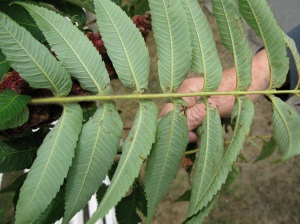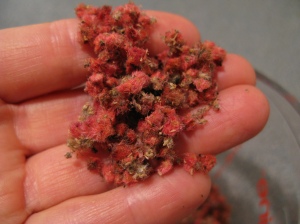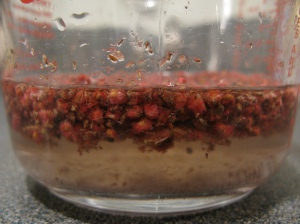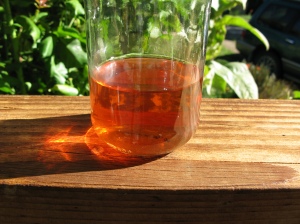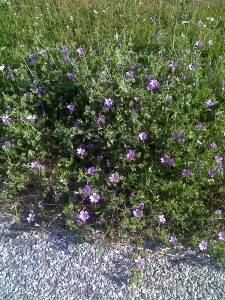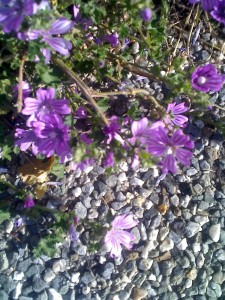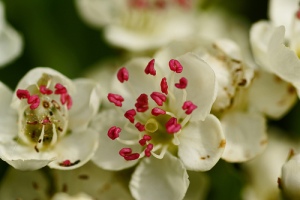You are currently browsing the category archive for the ‘water’ category.
I picked this up from the US herbalists. Sumac is a small tree that’s often planted in NZ gardens for ornamental value. It has distinctive red flower/fruit heads that last on the tree well after all the leaves have dropped. The trunk and branches are elegant, lending to the sculptural look.
This sumac is also known as staghorn sumac, Rhus thyphina, which helps differentiate it from related poisonous species*. The best way to ID sumac is by the ‘berries’. It took me a while to be sure that I had the right plant because sumac berries aren’t very berry like. Instead they are a horn-shaped cluster of small, red, furry bits:
I still haven’t found out if those are flowers, fruit or seeds, but the Americans call them berries.
The leaves are quite distinctive too, being obviously symmetrical:
Additional ID keys are the furry stems, and when you break them they ooze a white substance.
*If you read US sources of information about this plant there are cautions about not confusing it with poisonous sumac (a related plant). I don’t think this is an issue in NZ because (a) the poisonous sumac is rare (not sure if it even exists in NZ), and (b) it doesn’t look like staghorn sumac – poison sumac has drooping white berry clusters, not upright red ones. The leaves also look different.
Sumac Lemonade
Once you are sure you have the right plant, pick a few heads. It’s best to not pick straight after a rain, as rain washes off some of the tasty bits.
Pull the seeds off and put into a container.
Cover with cold water (yes, cold. Hot water makes the brew too strong) and squash the seeds a bit into the water.
I left mine overnight which made a very strong brew too, which I watered down. Subsequent batches I’ve made with 1 seed head to 2 cups of cold water, steeped up to an hour. Play around and see what works for you. When ready, strain the brew well to remove the fine hairs and bits of seed.
The taste of sumac is refreshingly sour and astringent. You can add honey or sugar if you like, but I’ve been happy drinking it as is. Drink a small amount the first few times to see how your body reacts – sumac is also medicinal and can make you pee more. I didn’t notice anything obvious and have been enjoying a glassful at a time.
You can dry sumac heads for later use (infusion or spice).
Things I want to try:
~ a longer infusion for maximum vitamin C extraction
~ a sumac berry vinegar (‘cos I have to try most things in a vinegar)
~ sumac as a dry spice (sumac is a traditional middle Eastern spice. A local forager told me to mix ground sumac, thyme and salt).
~ sumac honey
~ sumac and berries or other seasonal fruit (there’s a local company making sumac and plum relish).
Sumac resources
Matt Wood discusses on video different species of sumac, its use as a spice, and as medicine.
Susun Weed video on Euell Gibbons’ washing machine method for large batches of sumac lemonade!
I was out for the day yesterday, the first time I’d had to contend all day with the intense heat we’ve been having the past week. At a friend’s place for afternoon tea I went searching in his yard for something for a herbal brew and found some mallow. It wasn’t in flower yet, so I picked a handful of leaves, put them in a mug and covered with boiling water. I let this sit until it was warm (giving it time to brew), and then we drank it. It was mildly and pleasantly green tasting, and refreshing.
Mallow is perfect for hot dry climates and it’s a boon that it grows here. It’s rich in mucilage, which means it has complex sugars (carbohydrates) that form a gel like substance. The root of mallow’s cousin marshmallow was originally used to make the sweet marshmallow because of this mucilage. Mucilage in plants is thought to help the plant conserve water, and it’s also one of the properties used in herbal medicine – to help the body maintain moisture and not dry out.
There are a handful of different mallows growing in NZ. The one I found is probably the dwarf mallow, Malva neglecta, a low growing, almost prostrate mallow (or possibly it’s a small version of M sylvestris). On my travels later in the day I found the most fantastic stand of them flowering along the road.
Malva species are part of the Malvaceae family, a large group of plants that includes our native Houhere (Hoheria spp) which is also mucilaginous.
The common name mallow is used for Malva spp but also some others eg Lavatera arborea (tree mallow).
Mallows are fairly easy to ID. The flowers are distinctive, with five striped petals and usually purple or pink. The leaves are slightly furry, have a mild taste and will be a bit slimy when chewed. Here’s a few ID resources:
Mallows are edible and medicinal. The Malva mallow leaves and flowers can be eaten raw in salads, or made into tea or infusion. The leaves can also be cooked in soups and stews. I ate the leaves from our tea (a good way to experience the mucilaginous aspect of this plant). The green ripe seed pods are also edible and a traditional British wildfood treat known as ‘cheeses’.
When making tea or infusion there are several options. Mucilage extracts well into cold water, so a cold infusion is good if you have lots of plant and time. You can use leaves or flowers or both. Put a good handful of plant in a jar and cover with cold water. Steep 4 – 8 hours or overnight. Infusions high in mucilage will go off quickly so drink within a day or store somewhere cool.
As mentioned with the tea, mallow can also be a quick drink from fresh plant, made with hot water. The longer you leave it to brew the stronger the tea, bearing in mind this is a subtle plant – you won’t get much from just a few minutes. And it’s better on a hot day when it’s cooled a bit.
You can also make a hot infusion – use more plant and leave longer. If you have plenty of mallow, it’s nice to experiment and see how the different preparations taste and work in your body.
Mallows grow easily in the garden in a variety of climates – Malva sylvestris in particular is a great garden plant, putting out leaves and flowers over a long season for continual picking. Cut back in the autumn or winter for more lush growth the following year.
A friend and I have had several conversations recently about hawthorn. One of the things we had both been thinking about was the scent of hawthorn blossom. To some people it smells lovely, to others it smells rotten. Apparently there are two things going on there. Amygdalin is responsible for the attractive smell (the marzipan one, smells like almonds) and attracts bees. The other smell is apparently like decomposing flesh, and attracts insects who like that sort of thing, who also help pollinate (presumably flies). I don’t really smell the rotten scent, it’s there as an undertone sometimes but mostly I find the smell divine. But my friend’s partner can’t stand the smell. She wondered if it’s a male/female thing. I wondered if it’s to do with who needs what medicine (and smell receptors in the nose and brain). Probably where the tree is growing, and what the climate is like will have an influence as well. British sources speculate that different species of hawthorn have more of one smell than the other, but as far as I know the local species are all Crataegus monogyna.
Smell is a very useful tool in learning about medicine and which ones to take. The smell of a plant will signal to the body certain things about what the plant contains. If the plant is taken over time the body gets to know it, and then the smell can signal at other times that it’s right to be taking that medicine. Possibly my friend and I would do well with hawthorn blossom as medicine, but not her mate.
Although I’ve used the berries in tinctures and vinegars I’m new to hawthorn flowers and leaves as medicine. My initial ways of getting to know the plant include tasting, making infusions and tea, reading other people’s experiences, talking to my friend and visiting the plant often to see what is going on.
I started by tasting the flowers and was a bit surprised at an obvious bitter taste. It wasn’t overpowering, and it lessened with older flowers, but I had read about making such delights as hawthorn flower syrup and wine cup where you would expect a strong pleasant taste. The bitterness wasn’t offputting though and bitter is a very good flavour for human health, one that is missing from most modern diets, so a little bitter in my hawthorn is a good thing.
However once the flowers are steeped in hot water, the tea brings out the true hawthorn flavour. The bitterness is there in the background, but also a distinct pungent almost sweet flavour. Not sweet like sugar, but the subtle nectar of a small flower*. There’s also a greeness, as expected from the leaves. I made some blossom and leaf tea, about a cup of fresh flowers to 3 cups water, and drank some after 10 minutes, 30 minutes, and an hour.
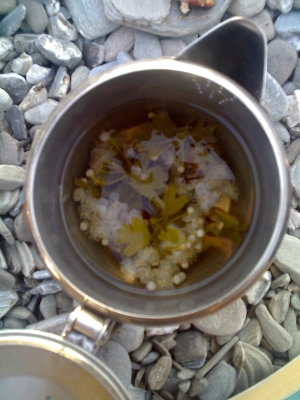
I found the brew almost immediately relaxing. It made me a bit sleepy, not a sedative but it definitely mellowed me out after a tense afternoon. The later stronger brew was even more so. I also found it relaxing to my digestive tract. After 10 minutes the tea had a green subtle taste. 30 mins and it was sweeter, still a bit green. In an hour a subtle bitter taste came through, might be from the bottom of the pot or the longer brewing.
Since then I’ve been making infusions and enjoying a couple of cups a day when I need to unwind. I’ve found hawthorn berry tincture has a similar kind of relaxant effect.
Hawthorn is well known as a heart tonic. In the US the focus seems to be on the berries, but I’ve been interested to see British and European sources talk about the leaves and flowers as the best medicine. Hawthorn’s ability to nourish the heart and assist in recovery from heart problems is well documented in traditional herbalism, contemporary herbalism and supported by science.
In the past week I’ve been harvesting the leaf and bloom clusters to dry for tea later once the spring is past. When you harvest make sure that you get flowers that aren’t too old. Give the branch a gentle shake and if some of the petals fall off it means the flowers are nearly done. They’re probably less potent and they’re likely to fall apart when you harvest and not dry so well.
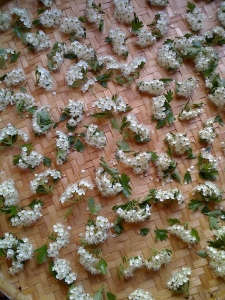
The flowers and leaves seem to dry easily. I’ve got them spread out on a cane tray and give them a shuffle every now and again. It’s a good idea to keep each cluster as separate as possible, they dry better that way. When they’re crisply dry I’ll store them in dark glass or paper bags.
*I did watch the bees on the flowers one day, and they were definitely feeding on something I had trouble finding. Hawthorn flowers have a single central pistil (that’s the monogyna bit in the Latin name)…
The pistil is the yellow tipped bit in the middle. At the bottom of that where it meets the petals was were the bees were feeding from. I couldn’t see anything that looked like nectar, but taking the flower apart and eating that middle bit yielded the sweetness.
Btw, that photo is from flickr (not a chance on my cellphone camera), and someone has left a comment there about how the pollen on the stamens looks like tiny red hearts! Brilliant. The pinkness doesn’t last though, and on most of the flowers I harvested the stamen end was black.
Further reading:
Brigitte of myherbcorner has a recent post on hawthorn.
Susun Weed’s article on hawthorn as a heart medicine.
I had a cold last week, only it was a hot one. What I mean by that is that I had a rhino virus (a ‘cold’) where the symptoms were signs of heat in my body not signs of coldness. I had had a few days of coughing up gunk from my lungs following some dusty work earlier in the week. By mid week my face and head became hot, and my nose was very dry. I was also tired in the viral infection kind of way, and craving cooling foods and drinks. And I was coughing ‘unproductively’ (meaning phlegm needed to come out but wasn’t). This is quite different than a cold cold, where you might feel cold in your body and crave warming foods and drinks.
My two main remedies were sleep and mullein infusion. Sleep and/or rest is by far the most important thing to do to recover from colds or flu’s well. The body needs energy to focus on the immune response (both increasing immune cell responses and removing the breakdown products via the lymphatic system). If we keep up our normal level of activity it can make it harder for our bodies to fight the infection.
Mullein is a wonderful healer of many lung complaints, including colds, bronchitis and asthma. It’s useful for the whole upper respiratory tract as well, but seems particularly gifted when it comes to lungs. Nourishing, soothing and moistening to mucous membranes mullein helps expel phlegm from the lungs. It is cooling which made it perfect for this cold. I normally get cold colds and so don’t use mullein often as a cold remedy (I prefer thyme). But this week it was a blessing. I picked 5 large fresh leaves…
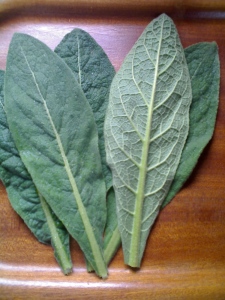
chopped them into a pot, covering them with 2 cups of boiling water…
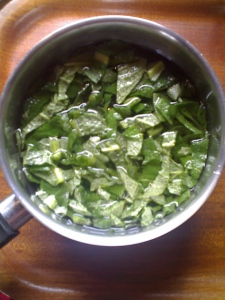
and simmered gently for a while (with a lid on).
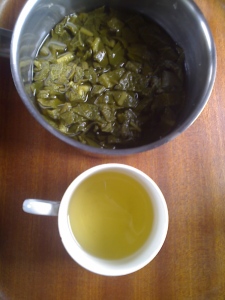
That pot has had some infusion taken out – the simmering shouldn’t reduce the amount of liquid much, but it provides enough heat to help break down the cell walls of fresh plants (not needed if the plant is dried). Mullein needs to be strained through a cloth to remove the fine hairs that can irritated the throat.
You could make an infusion like this without simmering, using fresh leaves, or dried. Dried leaves give a stronger medicine, but I’ve been partial to fresh plant infusions of mullein recently. It’s easy to make, and the plants are in full growth spurt, lush and abundant where I am, so it makes sense to use them for medicine at this time when they are so vibrant. I make mullein leaf tincture to use at other times and find it effective with many lung problems too.
I also made some calendula infusion (about a handful of whole flowers to a litre of boiling water, steeped for half an hour, preferably longer), which I drank later in the day to help my lymphatic system.
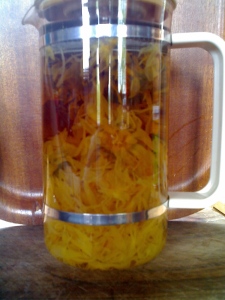
I drank several cups of the mullein infusion over the morning and afternoon, and the calendula in the evening. I had several naps during the day, ate a clove of garlic and vitamin C foods, and avoided exertion and stress. By the time I went to bed I felt fine. A few days later I got a bit chesty again (having been an idiot and overdone it work-wise), but another day of drinking mullein set me right.
If you have mullein local to you, try making an infusion and see what it is like. It’s good to get to know medicines before we really need them, and it’s good to be familiar with preparing them when we aren’t feel like crap. We’re much more likely to use them if we already have the practice.
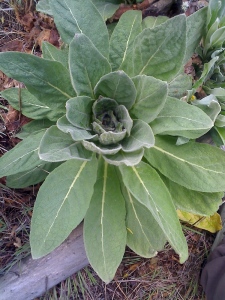
Everyone knows how to make herbal tea. Regular tea is a kind of herbal tea – it’s made from the herb Camellia sinensis*. So anyone who has made gumboot will understand the basic principles of making a water based herbal medicine. You need hot water, dried herb, and something to brew in.
But beyond that, water based herbal medicines vary depending on what you are trying to achieve. There are teas, infusions, and decoctions for internal use. As I mentioned in another post, those terms get used interchangeably and contradictorily by different people, so here is what I personally mean in this blog when I use those words:
Tea: a small amount of herb steeped in hot water for a shortish amount of time. Can be a refreshment or a medicine, but is less strong than an infusion.
Infusion: a large amount of herb steeped in water for a long period of time. The greater amount of herb and the longer time both mean a stronger medicine and more parts of the plant are extracted.
Decoction: simmering herb in water, or simmering an infusion to reduce it down and increase the strength of the brew. Decoctions are by definition stronger than teas or infusions.
Some important principles:
One of the ways plants protect themselves is by having very thick cell walls. In order to get to the nourishing and medicinal bits of the plant inside the cells we have to break the cell wall. Three things will do that in water preparations: drying, heat and time.
Drying: for the most part dried herb will extract into water far better than fresh plant. You can try this for yourself. Find a non-aromatic herb that you have both dried and fresh eg nettle, raspberry leaf, or calendula. Make a tea from the dried and from the fresh by putting 1 tsp into 1 cup of hot water. Cover and leave for 15 minutes and then compare taste, smell and what they look like.
Having said that, some herbs extract well as fresh plants. These are herb that are high in volatile oils (the aromatic oils you can smell) eg mint, rosemary, thyme, lemon balm. You can make water medicines from these as fresh plants because the volatile oils may be the medicinal parts you want and they extract into the water very easily (and if it’s the volatile oils you are after, they often extract better from fresh plant than from dried). They also smell great.
Heat: heat will break down plant cell walls (this is true of food too, and is one reason why well cooked food is often easier to digest and more nutritious). Hot water, just boiled, is perfect for tea and infusion making, extracting most plant parts more effectively than cold water. Hot water and dried plants are a good match. Again, you can try this yourself. Take some dried herb and make a tea from hot water and one from cold water, and then compare after 15 minutes.
Decoctions also use hot water, but hotter than in tea or infusion. With a decoction, you simmer the herb, or heat it just below simmer, for a period of time. This additional exposure to heat will break down tougher cell walls and so is used for tougher plant parts like roots and barks. It can also be used for fresh plant, where there has been no drying to assist the cell wall breakdown. Rongoa (Maori herbal medicine) seems to be a tradition that uses decoctions more than infusions, presumably because of the easy availability of fresh plant.
And again there are exceptions to the rule. Some plants have mucilage in them, a substance that produces slimey or jelly like medicines that are good for soothing mucous membranes eg the digestive tract. Mallows and marshmallow are classic examples of this. Mucilage extracts very well into cold water.
Time: and thirdly, time allows for greater extraction of medicine from the plants. The longer you leave a tea or infusion to brew the stronger it will be. This is important if you are wanting to get nutrients like minerals from herbs, as it takes time for them to extract into the water. An over night infusion will have more minerals in it than a 20 minute infusion.
It is possible to brew some herbs for too long. Chamomile is best brewed (as a tea) for no more than 20 or 30 minutes, otherwise it gets quite bitter.
You can use any combination of those three things to make the medicine you want. For example, if you want a mucilage medicine you can use cold water, but still use time and drying to help access what is inside the cell walls. Sometimes you want to limit the extraction. Some herbs are just too strong to do as an infusion (licorice and thyme are two herbs I make as teas). Sometimes you want a medicine in a hurry, so a tea or fast decoction is better than an infusion.
Here are some standard recipes:
Teas:
Lemon balm tea: take a handful of fresh lemon balm leaves, put in a tea pot, cover with 2 cups of boiling water. Steep 10-20 minutes.
Chamomile tea: put 1-3 tsp dried flowers in a tea pot and cover with a cup of just boiled water. Steep no more than 20 minutes.
Infusions:
Nettle infusion: take 30gm dried nettle leaf and put it in an agee jar. Add boiling water, being careful not to crack the jar. Stir with a wooden spoon to release air, and top up if needed. Put a lid on tightly, and leave to steep 4 hours or overnight. Strain and drink as is or reheat. This makes a nourishing infusion strong enough to supply large amounts of minerals that you simply won’t get from nettle tea.
Decoctions:
Echinacea: put 30gms dried echinacea root in a pot and cover with 500mls water. Put a lid on and slowly heat until just simmering. Simmer 30 minutes. You can strain and use then, or leave in the pot for further infusing, taking out what you need over time. This method makes a brew strong enough to help heal bacterial infections.
These are guidelines, laying out time honoured ways of getting the best medicine from plants. If you learn and practice these rules, then you can learn where and when to break them.
*but it’s not really a herbal tea. Neither is green tea (it’s unprocessed regular tea) or regular tea with herbal additives (eg jasmine tea).
Menstruum is an old word meaning solvent, and in herbal circles it refers to the substance (usually liquid) you use to extract certain properties from herbs, thus making a medicine.
The two menstruums most people are familiar with are water, and spirit alcohol (tinctures and extracts you buy in a health food shop are made with alcohol). But you can also make medicines with vinegar, honey, or oil/fat. Here’s an overview, and I’ll do separate posts in more detail on each menstruum.
Water: used for making teas, infusions, or decoctions for internal use, and compresses or foments for external use. They are used as is or as the base for further medicine making. The terms are used interchangeably and contradictorily by herbalists, so it pays to check what any individual actually means. Water is good for extracting minerals, vitamins, and other water soluble parts like tannins or mucilage. Usually hot water is used, but sometimes not.
Alcohol: used for making tinctures and liqueurs, or liniments for external use. It extracts properties that water can’t, and tends to produce a stronger medicine than water.
Vinegar: used for herbal vinegars. It is excellent at extracting minerals, so can be used to make a mineral supplement. Can be used to make tinctures for people that avoid alcohol but is not as potent as alcohol.
Oil: herbal oils are for external use, either as is or for making ointments or salves. Fat is the traditional menstruum but many people now use a vegetable oil.
Honey: a divine menstruum, virtually any tasty herb can be put up in honey for pleasure, food or medicine.



